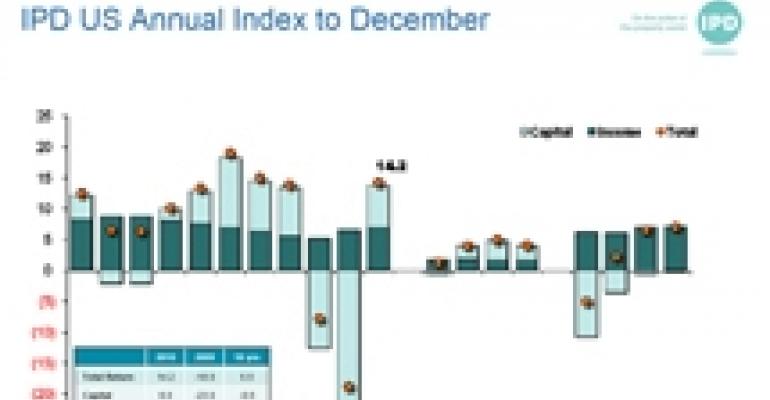IPD, a firm that tracks the commercial real estate performance and maintains several industry indexes, revealed that the commercial real estate funds it tracked posted a 14.2 percent return in 2010 making it the third strongest year in the 11 years that the firm has monitored the United States.
Of that, 6.9 percent was the result of capital return and 6.9 percent of income return. The 14.2 percent was a huge improvement over 2009, when IPD’s U.S. index showed a 18.9 percent decline in total return driven by a 23.9 percent drop in capital return that was only partially offset by a 6.5 percent income return. (Overall, IPD monitors 46 funds that own 3,100 assets with a capital value of $119 billion.)

The main driver for the 2010 results was that, “real estate capital markets recovered earlier and stronger than many anticipated,” said Simon Fairchild, managing director of IPD North America during an event on Monday revealing the index’s results. “The recovery in capital markets more than anything else is driving current values and pricing.”
REITs were big beneficiaries of the improvement markets, issuing nearly $20 billion in new debt and raising more than $25 billion in new equity from IPOs and secondary offerings. Meanwhile, the CMBS market also began to recover with total issuance in 2010 amounting to $11.6 billion—up from $2.7 billion in 2009.
The recovery led to an increase in investment sales volume globally, according to data from Real Capital Analytics. According to the firm, which tracks property sales of greater than $5 million, investment sales volume for U.S. commercial real estate amounted to $117 billion in 2010—just more than double the $54.6 billion that traded in 2009.

At the same time, the picture is far from uniform with IPD’s index showing varied performance by property type and by geography. By property type, apartments led the way in 2010 posting total returns of 19.7 percent followed by retail (14.9 percent), office (12.6 percent) and industrial (10.4 percent). Geographically, the East was the strongest region (15.5 percent), followed by the West (14.7 percent), the South (12.4 percent) and the Midwest (10.2 percent).
Going forward, investors that strike quickly may still be able to reap double-digit returns, even on core assets. But the spreads will likely tighten quickly, according to a panelists at a discussion held at the event. The panel featured Jeff Barclay, managing director, Goldman Sachs, Robert White Jr., founder of Real Capital Analytics, Michael Giliberto, president of S. Michael Giliberto & Co. and Bob Ruggles, president, Altus Group.

“There are still markets out there to get very good returns near-term,” Ruggles said. “The question is, how disciplined will we be this time around?”
White added that in the deals Real Capital Analytics has tracked, the gap in property values seems to be closing between primary and secondary markets faster than the gap between core assets and value-add properties.
The panelists also commented on the surprising strength of the retail sector, especially considering that the employment situation remains troubled.
“We’re all amazed at how retail has bounced back,” Barclay said. “The death of the industry was grossly exaggerated.”
That strength has translated into more investors targeting the sector. The institutions IPD tracked were net buyers of retail in 2010 while being net sellers of office properties. Their holdings of apartments and industrial properties remained stable.

